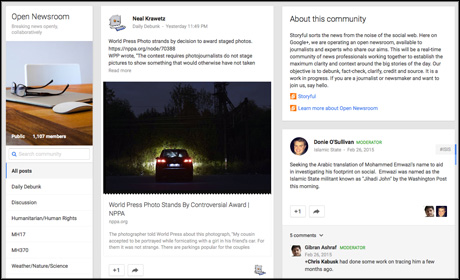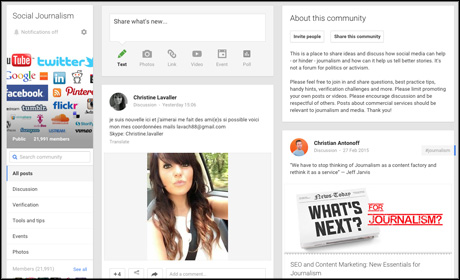
Google+ Communities – Google's take on Facebook Groups – have been around since 2012, but have struggled to find foothold in the crowded social media space.
They can still prove useful and productive however, as Ezra Eeman, founder of Journalism Tools, recently launched a community for journalists to share new apps and tools they find useful in their day-to-day work.
Here are some tips from Storyful's news editor (Europe) Joe Galvin, who co-manages the outlet's thriving Open Newsroom on Google+, and Sue Llewellyn, who founded the now-retired Social Journalism community.
Go private
Llewellyn believes one of the reasons the Social journalism Google+ Community didn't succeed is because it was a public group, meaning anyone could join without being vetted.
Initially, she said, the community comprised mostly people she followed on other social platforms, although two years later "almost every single post is blocked as spam... I've got 21,694 members in my community and it's all shit."
"A private community might give you more of a sense of belonging, or exclusivity, or feeling special," she said.
On the plus side, Llewellyn noted Google+ had a "very effective spam filter".
Think niche
Google+ Communities seem to work better for specific areas rather than "broad brush" subjects, said Llewellyn.
For example, Jonathan Sheppard, a member of the Social Journalism community, said he runs "a 7,500-member football community, which he found "intensive, with little return".
However, he also runs a community with just 40 members, which he stated was "perhaps my most productive space on the internet".
One of the reason Storyful's Open Newsroom – which centres around verifying information in the event of breaking news – has been so successful, she said, is because "there's a very small community of people who know what they're doing in that space".
Llewellyn also noted that community moderators could target posts further by making them visible only to certain 'circles', rather than the group as a whole.

Screengrab from Storyful's Open Newsroom
Engage influencers to get the ball rolling
There were two significant events which contributed to Storyful's Open Newsroom, which now has more than 1,100 members, gaining prominence just a few months after its launch in summer 2013.
The violence which erupted in Egypt that August, soon followed by an alleged chemical weapons attack in East Ghouta, Syria, both gave rise to a lot of content which required investigation and collaboration with sources on the ground.
However, the community also benefited from some "early adopters" who were already experts in online investigation and verification who in turn brought their own followers with them.
"Very early on we had a small and strong community," explained Galvin.
Storyful had worked with Eliot Higgins, aka Brown Moses, and James Miller, now managing editor of The Interpreter, on various projects relating to Syria prior to starting Open Newsroom.
"We knew these were the key guys to get involved early on," said Galvin, "and they have youth communities that follow their work, so again that brought in people that they were familiar with."
NGOs such as Amnesty International and Human Rights Watch also offered the project an element "of authenticity and respect", he added.
Post regularly
Another reason Social Journalism failed to thrive on Google+, Llewellyn said, is because she wasn't able to dedicate enough time to it.
"It's like anything, you know, you can't just leave a garden and expect it to grow," she said. "You've got to nurture it and plant some things and some seeded ideas."
However, one of the challenges with Google+, she said, is that it's not "a massively busy space" – another reason why targeting niche communities can reap more rewards.
This is also something Ezra Eeman has come across since starting up the Journalism Tools community. "It's certainly hard to get some kind of engagement," he told Journalism.co.uk via email. "Most people just lurk around."
"It's a labour of love if anybody's going to do it," Llewellyn agreed, "and you really need the right people on your team, I think, because no one person can do it themselves. And I do think [posting] needs to be really regular."
Choose moderators carefully
When Llewellyn started the community, she invited 20 people who she thought might be interested in moderating it.
In hindsight, she said, this was "too many" and "only one of [them] actually did anything".
"I think three is probably enough... but I think there's got to be something in it for the moderators to make it really work," she added.
On the other hand, more active communities may benefit from more moderators. Galvin noted that all Storyful staff, plus a few external experts, were moderators on Open Newsroom – around 40 people in total. "The level of moderation required is relatively minor," he added.

Screengrab from Social Journalism
Create a 'cordial and respectful' environment
Galvin noted that insults and personal attacks are rare within Open Newsroom, although there were occasional clashes of opinion.
"What we do first of all is wait and see if it resolves itself," said Galvin. "Sometimes things will get a little bit heated and people will apologise or back off."
If that doesn't happen, Galvin said he or one of the team will send an email CCing both members to ask them to remain "cordial and respectful".
"It's worked very well," he said. "We've only had a couple of incidents since we started Open Newsroom, and they were resolved very quickly with no problems.
"We understand that people are very passionate about certain issues – they are going to get slightly aggravated if what they see as truth is being challenged.
"We don't want to boot anyone out [of the community] for being passionate, we want to give them a chance to explain themselves."
Experiment
Despite some of the challenges associated with Google+, both Llewellyn and Galvin pointed out it had proved to be a good space for experimentation.
Llewellyn noted that when Google+ Communities first launched she was keen to try them out to see "what it was like having a public form" where "anyone can join".
She hasn't ruled out having another stab at creating a Google+ Community – although next time she said it will be a closed group.
Storyful too have found Open Newsroom so rewarding that the outlet is now planning to take it to the "next level" and build a new, custom platform for investigations based around specific topics, something Galvin described as "more in-depth, more longform".
"For us, it [Open Newsroom] was kind of an experiment to see what we could do with a safe space for investigation," he explained.
Sue Llewellyn will be running a course on social media content strategies in collaboration with Journalism.co.uk in London on Thursday 19 March.
Do you have any more tips for successfull Google+ Communities? Let us know in the comments below.
Free daily newsletter
If you like our news and feature articles, you can sign up to receive our free daily (Mon-Fri) email newsletter (mobile friendly).
Related articles
- Journalists are happy to be disconnecting from platforms, should news organisations be worried?
- Protecting journalists on social media, with Valérie Bélair-Gagnon
- 10 creative ways to interview celebrities and experts
- What will your audience want in the future?
- New resources to help journalists fight elections misinformation









